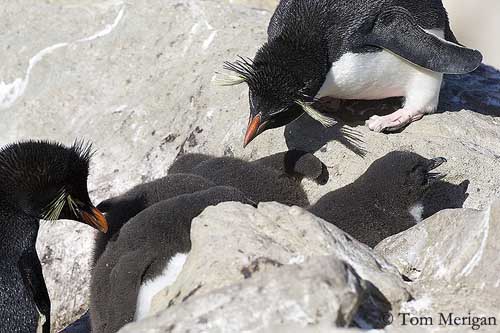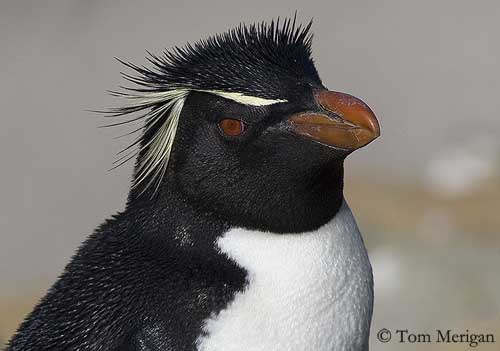
Fr: Gorfou sauteur
All : Felsenpinguin
Esp : Pingüino Penacho Amarillo
Sd: Klipphopparpingvin
Port: pingüim-de-penacho-amarelo
Photographer:
Tom Merigan
Tom Merigan’s Photo Galleries
Text by Nicole Bouglouan
Sources:
HANDBOOK OF THE BIRDS OF THE WORLD vol 1 by Josep del Hoyo-Andrew Elliot-Jordi Sargatal - Lynx Edicions - ISBN: 8487334105
BirdLife International (BirdLife International)
Antarctic Connection (Thomas Hutchings – Gloria Hutchings)
PENGUINS AROUND THE WORLD (Tammy Payton)
Penguins of the world (Mike Bingham)
Southern Rockhopper Penguin
Eudyptes chrysocome
Sphenisciforme Order – Sphenicidae Family
BIOMETRICS:
Length: 55-62 cm
Weight: 2 - 3, 5 kg
DESCRIPTION:
The Southern Rockhopper Penguin is the smallest of yellow-crested penguins of genus Eudyptes.
It has black head, neck and upperparts, including tail and flippers. The underparts are white. The underside of the flippers is white with black edges.
On the head, the yellow crest is made of two separate parts formed by yellow supercilium extending behind the eye in elongated, thin feathers. The occipital crest is black.
The thick bill is pinkish-red to reddish-horn. The eyes are red. The short legs and the webbed feet are pale pink with black claws.

Male and female have similar appearance, but the male is often larger and has thicker bill.
The chick has grey head and upperparts, and white underparts.
The juvenile has duller bare parts and shorter yellow crest.
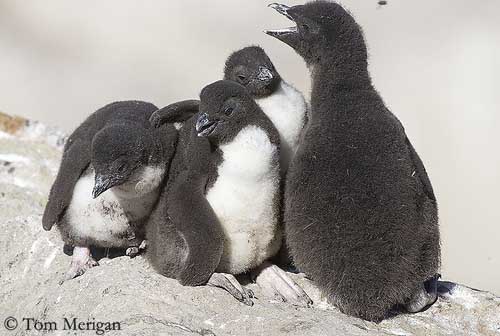
We find three subspecies:
E.c. chrysocome occurs in Falkland’s Islands and Cape Horn.
E.c. filholi is found in southern Ocean, from Prince Edwards Island to Antipodes Island. This one has pink and fleshy bill margins.
E.c. moseleyi occurs in S Atlantic (Tristan da Cunha and Gough islands) and S Indian Ocean (Amsterdam and St Paul Islands). This one is larger, with longer and denser yellow crest.
VOICE: SOUNDS BY XENO-CANTO
The Southern Rockhopper Penguin can be noisy at breeding colonies, when competitions occur for territory, mates and nest materials. They utter very loud cries as advertising calls.
HABITAT:
The Southern Rockhopper Penguins are marine and pelagic. They breed on rocky shores and cliffs, lava flows, slopes, near the coast but sometimes inland, among tussocks of grass.
RANGE:
The Southern Rockhopper Penguin is a sub-Antarctic species. See above in “subspecies”.
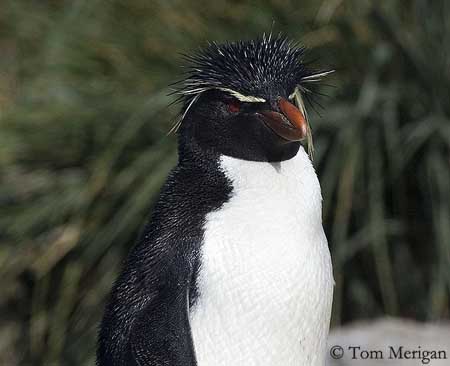
BEHAVIOUR:
The Southern Rockhopper Penguin also communicates by head shaking or head and flippers weaving, bowing, gesturing and preening.
When they shake the head, the yellow crest moves into a “halo” and is used to attract a mate.
It feeds on krill, fish and squid, caught by pursuit-diving during which the webbed feet and the flippers are used for swimming rapidly. They enter and emerge from the water thanks to their good hopping abilities.
Unlike numerous other penguins which move by sliding on their belly, the Rockhopper Penguin prefers to jump over rocks, boulders and rocky cracks.
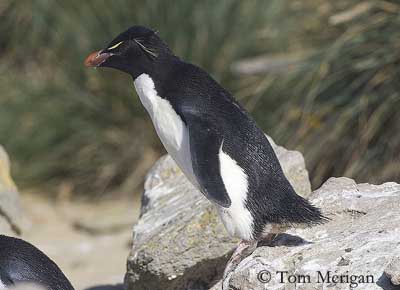
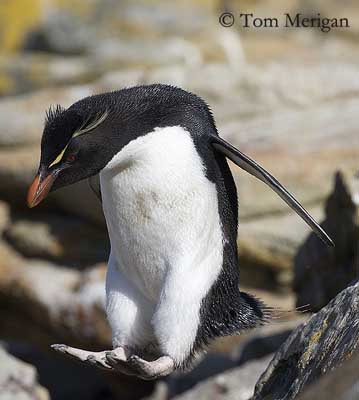
It remains at sea from April/May to September/October after the moult, and before to start the breeding season.
The Falkland’s population moves to coastal Argentina.
The species is vagrant to South Africa, New Zealand, Australia and Antarctica.
MOVEMENTS:
The Southern Rockhopper Penguin does not fly in the air but only underwater!
The webbed feet and the powerful flippers allow it to swim rapidly.
REPRODUCTION:
The breeding season varies according to the range.
The Southern Rockhopper Penguin breeds in colonies from sea-level to cliff-tops, and sometimes inland. The nest is a scrape in the ground, often lined with dried grasses, but other materials can be found, such as stones or bones.
The female lays two eggs and the incubation lasts 32-34 days, shared by both adults. They take turns with stints of 7 to 17 days. The chick is brooded by the male while the female brings the food, but the male is able to provide “milk” which is regurgitated for the chicks.
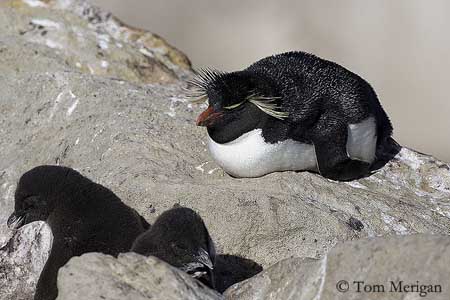
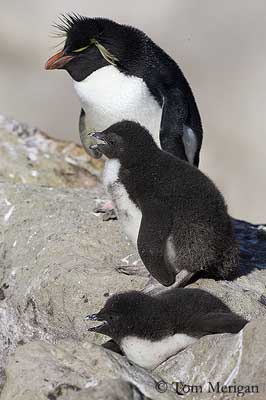
When the young are 3 weeks old, they gather at crèches with other chicks, where they are protected and reared.
They moult and leave the nesting grounds for the open sea about 65-72 days after hatching. They can live about ten years.

DIET:
The Southern Rockhopper Penguin feeds mainly on fish, krill, squid and crustaceans. They pursue the prey by swimming underwater.
PROTECTION / THREATS / STATUS:
The Southern Rockhopper Penguin is preyed upon by sharks and seals at sea, and on land, skuas, petrels and gulls take eggs and chicks.
The species is classified as “Vulnerable”, due to rapid declines, even in recent years. Increasing disturbances, pollution, introduced predators and ecotourism may affect the breeding success.
The Rockhopper Penguin is protected by laws, and occurs on islands in reserves.
